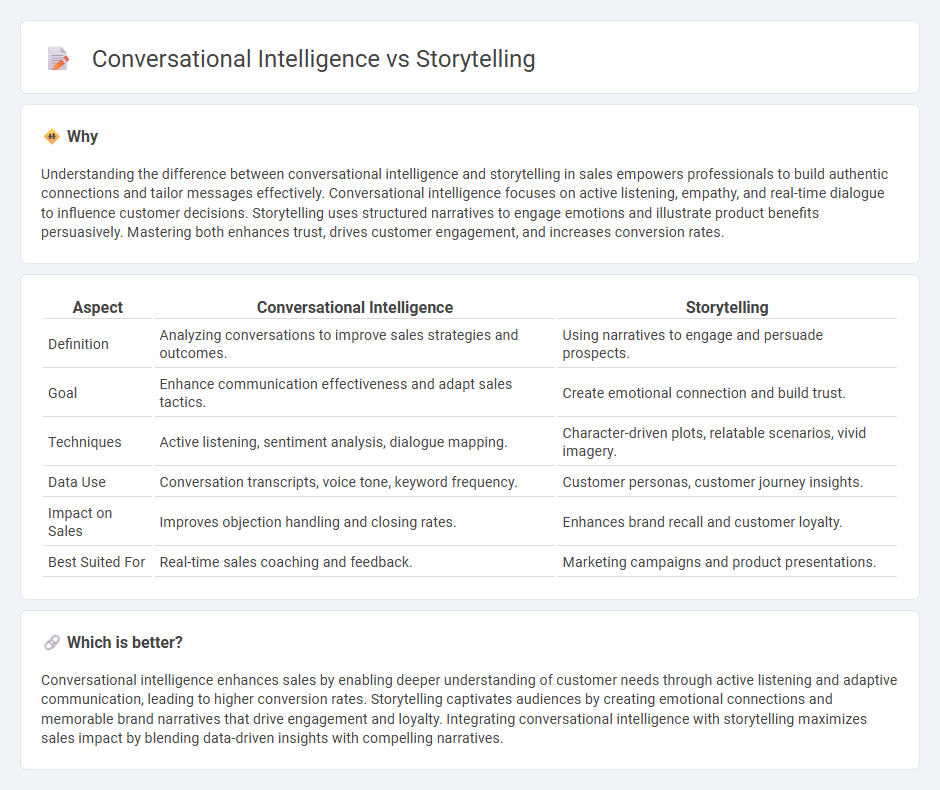
Conversational intelligence enhances sales by analyzing customer interactions to uncover insights, improving communication and closing rates. Storytelling in sales creates emotional connections, making products memorable and persuasive to potential buyers. Explore how integrating conversational intelligence and storytelling can revolutionize your sales strategy.
Why it is important
Understanding the difference between conversational intelligence and storytelling in sales empowers professionals to build authentic connections and tailor messages effectively. Conversational intelligence focuses on active listening, empathy, and real-time dialogue to influence customer decisions. Storytelling uses structured narratives to engage emotions and illustrate product benefits persuasively. Mastering both enhances trust, drives customer engagement, and increases conversion rates.
Comparison Table
| Aspect | Conversational Intelligence | Storytelling |
|---|---|---|
| Definition | Analyzing conversations to improve sales strategies and outcomes. | Using narratives to engage and persuade prospects. |
| Goal | Enhance communication effectiveness and adapt sales tactics. | Create emotional connection and build trust. |
| Techniques | Active listening, sentiment analysis, dialogue mapping. | Character-driven plots, relatable scenarios, vivid imagery. |
| Data Use | Conversation transcripts, voice tone, keyword frequency. | Customer personas, customer journey insights. |
| Impact on Sales | Improves objection handling and closing rates. | Enhances brand recall and customer loyalty. |
| Best Suited For | Real-time sales coaching and feedback. | Marketing campaigns and product presentations. |
Which is better?
Conversational intelligence enhances sales by enabling deeper understanding of customer needs through active listening and adaptive communication, leading to higher conversion rates. Storytelling captivates audiences by creating emotional connections and memorable brand narratives that drive engagement and loyalty. Integrating conversational intelligence with storytelling maximizes sales impact by blending data-driven insights with compelling narratives.
Connection
Conversational intelligence enhances sales by enabling deeper understanding of customer needs through active listening and strategic questioning. Storytelling leverages this insight to craft compelling narratives that resonate emotionally, building trust and driving engagement. Together, they create persuasive sales interactions that foster long-term client relationships and increase conversion rates.
Key Terms
Narrative Structure
Narrative structure in storytelling involves a clear beginning, middle, and end, designed to engage audiences through characters, conflict, and resolution. Conversational intelligence emphasizes the dynamic flow of dialogue to build trust, understand perspectives, and foster collaboration. Explore how mastering these frameworks enhances communication effectiveness and relationship-building.
Active Listening
Active listening enhances both storytelling and conversational intelligence by fostering deeper understanding and engagement through attentive response and empathy. Storytelling benefits from active listening by tailoring narratives to audience feedback, while conversational intelligence relies on it to build trust and facilitate meaningful dialogue. Explore how mastering active listening can transform your communication skills and interpersonal connections.
Emotional Engagement
Emotional engagement in storytelling leverages vivid narratives and relatable characters to evoke empathy and create a lasting connection with the audience. Conversational intelligence emphasizes active listening, emotional recognition, and dialogue dynamics to foster trust and mutual understanding in real-time interactions. Explore deeper insights into how these techniques enhance emotional engagement across communication platforms.
Source and External Links
What is Storytelling? | IxDF - The Interaction Design Foundation - Storytelling involves a sequence of plot, characters, setting, conflict, theme, emotion, narrative perspective, and resolution, used especially in design to build empathy and insight by connecting with users emotionally.
11 Strategies to Tell a Good Story - BetterUp - Storytelling is the art of using language, voice, and physical expression to reveal the narrative and images of a story, creating connection through moments listeners relate to and engaging them emotionally.
Storytelling - Wikipedia - Storytelling is a social and cultural activity involving sharing stories with elements like plot and characters, often used for entertainment, education, preserving culture, or imparting morals, and commonly includes improvisation and theatrics.
 dowidth.com
dowidth.com